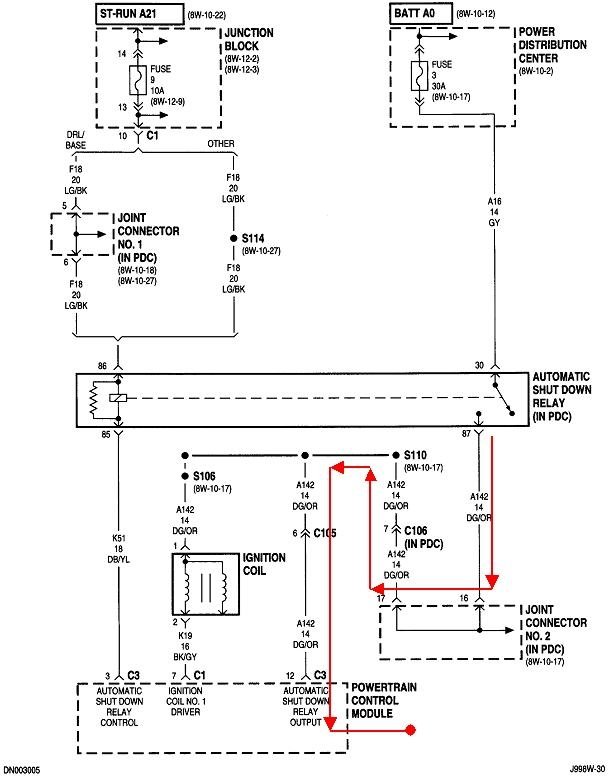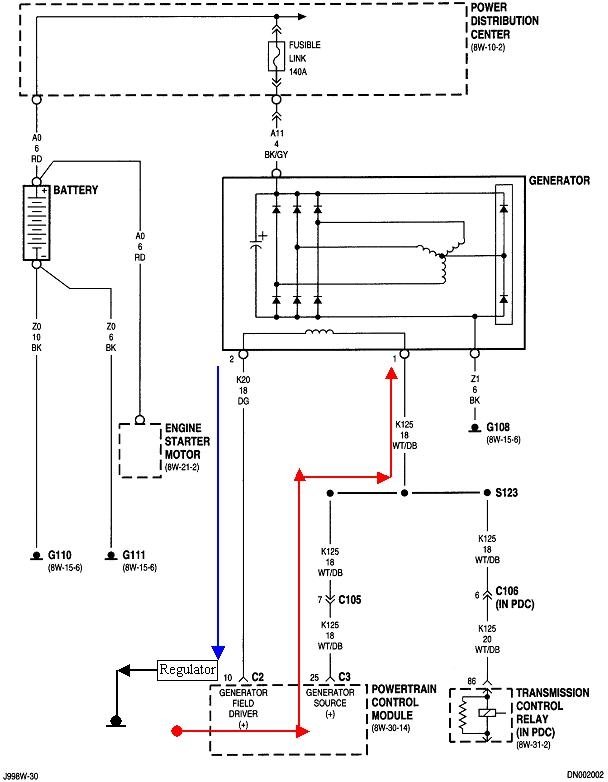I was 62 last month, but not now.
The terminology is what makes this confusing. On the diagram, it looks like the current to run the field winding comes out of the PCM, but in fact, that is backward. Well, I gotta qualify that. On the Dakota / Durango, they run the circuit through the computer instead of to the computer.
It's the automatic shutdown, (ASD) relay that supplies 12 volts to the field terminal, along with the ignition coil pack, injectors, oxygen sensor heaters, and a few other things. The dark green / orange wire is the "ASD Output" circuit leaving the relay, so that is what they call that wire going into the PCM. That's terminal 12 in connector C3. The "output" circuit is the "input" to the PCM.
When the PCM turns the ASD relay on, this terminal is where the 12 volts appears, to provide proof it got turned on. It always was the 12 volt supply to feed other things that were turned on and off by the computer, but now they needed to complicate the circuit unnecessarily. The white / dark blue wire you have used to be just another dark green / orange, and was spliced right to the other ones that go to the ignition coil and injectors. It still does that, but by way of two terminals that are connected together. In fact, terminals 12 and 25 in connector C3 are right next to each other, and they are connected internally.
My community college was one of three remote training sites for Chrysler in my state. In return for using our facilities, they often donated vehicles to us after they had been poked and prodded by their students. One of them was a Dakota with this same circuit. It was due to a mistake made by a pair of my students that burned that copper trace. Upon taking the PCM apart and finding that, I figured out those two wires could be spliced together outside the computer without changing anything related to how the system works. I can't think of any logical reason to do that except to make the computer easy to destroy through improper diagnostic techniques.
Up to my last red arrow, terminal "1" on the alternator, there will be full system voltage everywhere on that line, with no involvement of the computer other than passing between those two terminals. Terminal "2" on the alternator is the control side that goes to the voltage regulator circuit in the PCM, terminal 10, connector C2, and then to ground to complete the circuit. That has usually been that dark green wire on most models. When the regulator draws this voltage down, the current flow through the field winding creates the electromagnetic field needed to generate the output current and voltage. The lower it draws the voltage down, the greater the difference will be between the two terminals, and the stronger the magnetic field will be. The typical range of voltage you'll find on that wire is between 4 and 11 volts.
One of the clues to determining the cause of over-charging is if that dark green wire is rubbed through and grounded, you'll find 0 volts on terminals "2". If the voltage regulator is shorted, you'll find a minimum of around 2.0 volts. Due to the interconnected internal circuitry, a shorted regulator can't draw the voltage all the way down to 0.0 volts.
If the fuse you added is in the white / dark blue wire, that wire is all it's going to protect. If you accidentally ground terminal "1" at the alternator, the fuse will blow, then only the charging system will be dead. More commonly it will be the dark green orange wire that falls down onto hot exhaust system parts, melts through, and shorts to ground. That would blow the 30-amp fuse "3".
If the voltage regulator were to short, that would be the same as grounding terminal "2", which is what we do to perform the full-field output current test. Field current can't go much higher than 3 amps, so a fuse anywhere in that circuit will never blow.
Most people aren't aware that Chrysler developed the first "AC generator" for 1960 models and copyrighted the term, "alternator". GM was the first to copy the idea, but not until the '64 models. Chrysler also had the first electronic voltage regulator in 1970. That is the one you're referring to as a modification. That is relatively easy to do, and it will work, but that will turn on the Check Engine light, then you'll never know if or when a different problem shows up since the light is already on. Anything the computer detects and sets a fault code for that could adversely affect emissions are the codes that turn on the Check Engine light. The thinking is with low system voltage, the injectors won't fire properly and spark will be weak. Those can increase emissions.
The regulator switches the ground for the dark green wire on and off about 400 times per second, and it varies that "duty cycle" to vary the average field current. When you cut that wire to run to an external regulator, the computer will see the lack of field current through the PCM, and set the fault code, "field current not switching properly". I suggested to the last person contemplating this modification to add a power resistor between the dark green / orange wire and the cut wire at terminal 10, C2. That would give it some current to switch on and off and let it think it's doing its job. That should prevent it from setting a code and turning the Check Engine light on. That would need to be about a four to six ohm resistor, at least a 25 watt. The last person never posted a follow-up to say if that worked.
Images (Click to make bigger)
Friday, April 26th, 2019 AT 11:46 PM




